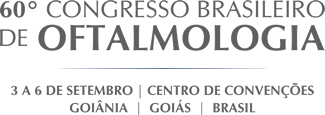Sessão de Encontro com o Autor – Tema Livre
Código: TL07
Área Técnica: Glaucoma
INSTITUIÇÃO ONDE FOI REALIZADO O TRABALHO
- Principal: Universidade Federal de Minas Gerais (UFMG)
- Secundaria: University of California San Diego, La Jolla, CA, United States
AUTORES
- ALBERTO DINIZ FILHO (Interesse Comercial:NÃO)
- Linda M. Zangwill (Interesse Comercial:NÃO)
- Akram Belghith (Interesse Comercial:NÃO)
- Robert N. Weinreb (Interesse Comercial:NÃO)
- Felipe A. Medeiros (Interesse Comercial:NÃO)
Título
PROGRESSION IN GLAUCOMA SUSPECTS IS DETECTED EARLIER WITH IMAGING THAN STANDARD AUTOMATED PERIMETRY
Objetivo
To estimate differences in time to detect progression in glaucoma suspects followed over time with standard automated perimetry (SAP) and optical coherence tomography (OCT).
Método
This was a prospective observational cohort study involving 373 eyes of 247 patients suspected of having glaucoma. All eyes had normal SAP results at baseline and were followed for an average of 4.6±1.0 years with an average of 8.8±2.9 SAP and OCT tests. For each eye, ordinary least squares (OLS) linear regression models were used to regress SAP mean deviation (MD) and spectral domain OCT global RNFL thickness values over time. Residuals were extracted from OLS regression to represent the expected variability estimates for levels of SAP MD and RNFL thickness. Distributions of residuals were then obtained for each level of MD or RNFL thickness in the population. These distributions allowed reconstruction of SAP MD and OCT global RNFL thickness trajectories over time by computer simulation, according to expected “true” rates of glaucoma progression. 100,000 tests were then simulated for SAP and OCT under different assumptions about baseline severity of disease, rate of change, and frequency of testing. Empirical cumulative distribution functions (CDF) were built to investigate the probability of detecting progression (statistically significant slope) over time.
Resultado
When simulations were performed assuming OCT global RNFL thickness of 90.0 μm at baseline and SAP MD of -0.2 dB at baseline, rates of progression of -0.75 μm/year for OCT global RNFL thickness and -0.12 dB/year for SAP MD (mean rates of change in the cohort), and annual testing interval, the respective average times to detect progression were 10.0±4.3 and 7.0±2.9 years, respectively for SAP and OCT. For 80% power and average rates of change found in the population, OCT would detect progression 4.3 years earlier than SAP.
Conclusão
When trend-based methods are used to evaluate change in global indices of structure and function, detection of progression occurs earlier with OCT than SAP.









